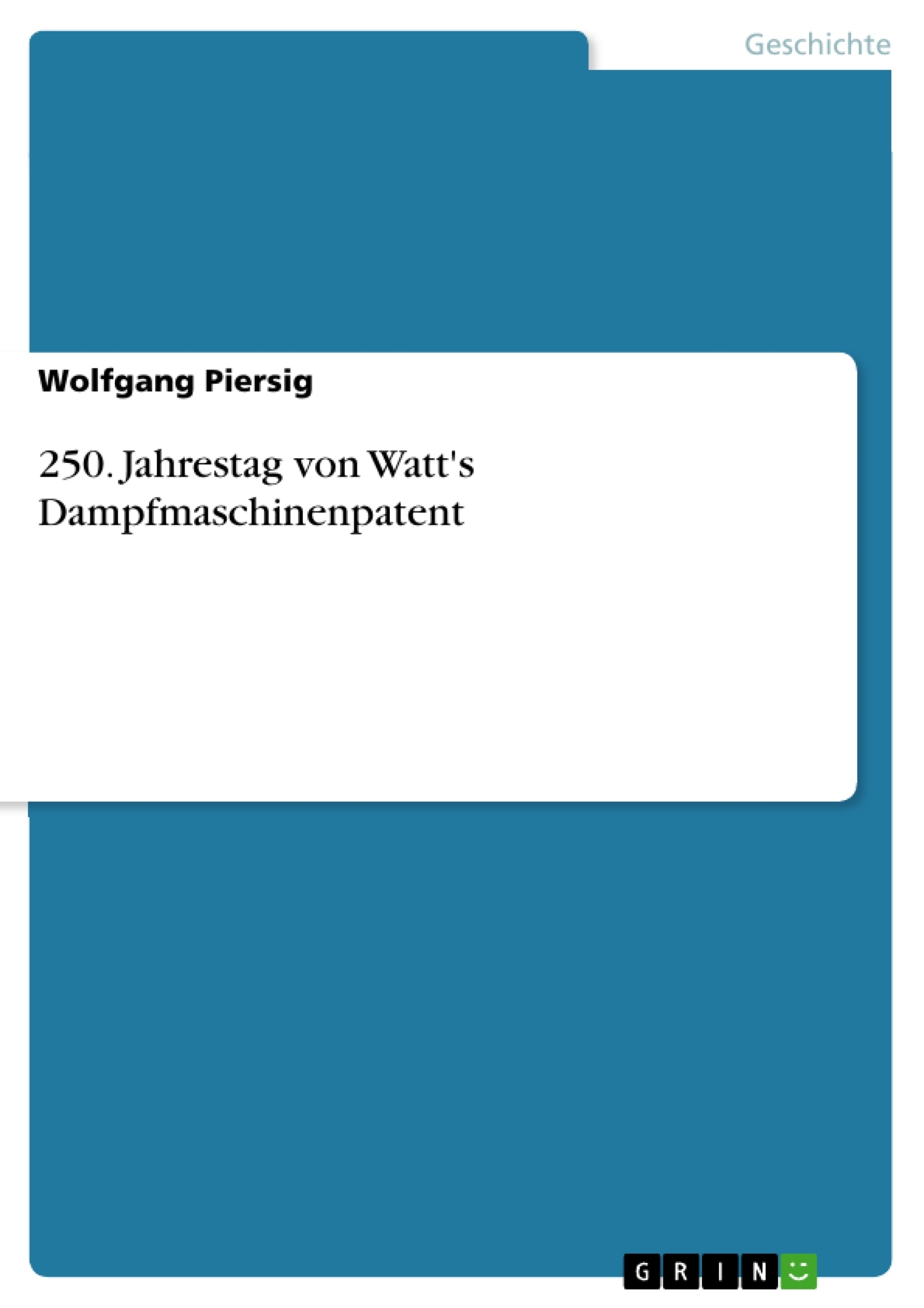Mit der Veröffentlichung zum Thema „250. Jahrestag von Watt's Dampfmaschinenpatent“ möchte der Autor an die Entwicklung der Dampfmachine, besonders an die Pionierleistungen des Schotten James Watt (1736-1819) zur Erfindung und Patentierung seiner einfach wirkenden Dampfmaschine (1769), wie auch Watts doppelt wirkenden Dampfmaschine (1784) erinnern. Aus einer erarbeiteten Zeittafel zur Luft-, Wasser- und Dampfnutzung von um die Zeitenwende bis etwa 1900 und Bildern zu ersten Feuermaschinen von Giambattista Della Porta (um 1600), Denis Papin (1690), Thomas Savery (1698), Denis Papin (1706),Thomas Newcomen (1712), James Watt (1769), nebst Funktionsskizzen zu Watts Maschinen, soll die Sicht auf das von Watt Geleistete erweitert werden. Erkennbar gemacht wird außerdem auch, dass die aufgezeigten Dampfmaschinen des 17./18. Jhs. eine nur mäßige Arbeit, leisteten, zweitens, dass sie nicht nur kompliziert, sondern auch wenig energieeffizient waren und Dampf lohnend nutzbar zu machen, erst James Watt mit seinen Dampfmaschinen schaffte, weshalb er als der eigentliche Erfinder dieser Maschinen benannt ist. Sichtbar macht die Zeitachse auch, dass es nicht korrekt wäre zu behaupten, Watt habe die Dampfmaschine entwickelt, was zuvor Denis Papin rund 80 Jahre vor ihm bereits tat. Aus ihr geht dazu hervor, dass der schottische Erfinder James Watt mit seinen verschiedenen Verbesserungen dafür sorgte, dass die Dampfmaschine mitentscheidende Triebkraft der industriellen Revolution wurde, und Watts wohl wichtigste Idee der separate Kondensator war, in dem der erhitzte Wasserdampf kondensieren konnte.
Vermittelt wird ebenso, dass Watt mit seiner Erfindung den Wirkungsgrad der Dampfmaschine von 0,5 auf 3,0 % versechsfachte, damals war dies ein Quantensprung.
Inhaltsverzeichnis
- Einleitung
- James Watt (30. Januar 1736–25. August 1819) und sein Patent N° 913.
- Watt's Method of Lessening the Consumption of Steam & Fuel in Fire Engines. A.D. 1769 N° 913. Steam Engines, &c. Watt's Specification.
- Übersetzung von James Watts berühmten ersten Dampfmaschinenpatent.
- Zeittafel zur Luft-, Wasser- und Dampfnutzung von um die Zeitenwende bis etwa 1900.
- Ausgewählte Bilder zu den Voraussetzungen und erste Versuche für Feuermaschinen von Giambattista Della Porta (um 1600), Denis Papin (1690), Thomas Savery (1698), Denis Papin (1706), Thomas Newcomen (1712), James Watt (1769).
- Ausgewählte Funktionsskizzen zu James Watts Dampfmaschinen.
- Watts einfachwirkende Dampfmaschine von 1776 und ab etwa 1780.
- Watts doppeltwirkende Dampfmaschine mit Drehbewegung (1784).
- Auswahl der recherchierten Literatur.
- Die wichtigsten verwendeten Abkürzungen
- Die Veröffentlichungen des Autors im GRIN Verlag.
Zielsetzung und Themenschwerpunkte
Der Autor möchte mit dieser Publikation an die Entwicklung der Dampfmaschine erinnern, insbesondere an die bahnbrechenden Leistungen des schottischen Ingenieurs James Watt (1736-1819). Die Arbeit beleuchtet die Erfindung und Patentierung seiner einfach wirkenden Dampfmaschine (1769) sowie seiner doppelt wirkenden Dampfmaschine (1784). Mithilfe einer Zeittafel und Bildern von frühen Feuermaschinen soll die Leistung von Watt verdeutlicht werden.
- Die Entwicklung der Dampfmaschine von ihren Anfängen bis zur Zeit Watts
- Die Bedeutung von Watts Erfindungen für die industrielle Revolution
- Die Funktionsweise und die Effizienz von Watts Dampfmaschinen
- Die Ehrungen und Auszeichnungen, die James Watt für seine Leistungen erhielt
- Der Einfluss von Watts Erfindungen auf die technologische Entwicklung
Zusammenfassung der Kapitel
Die Einleitung führt in die Thematik des 250. Jahrestags von Watts Dampfmaschinenpatent ein und skizziert die zentralen Themen der Arbeit. Anschließend wird die Bedeutung von James Watts Patent (Nr. 913) für die Technikgeschichte und die industrielle Revolution hervorgehoben. Die Übersetzung des Patents wird präsentiert, gefolgt von einer Zeittafel zur Entwicklung der Luft-, Wasser- und Dampfnutzung. Bilder von frühen Feuermaschinen und Funktionsskizzen von Watts Dampfmaschinen veranschaulichen die technologischen Fortschritte.
Schlüsselwörter
Dampfmaschine, James Watt, industrielle Revolution, Patent, Technikgeschichte, Feuermaschine, Zeittafel, Funktionsskizzen, Leistung, Effizienz, Kondensator, Erfinder, Ingenieur, Technologie, Innovation, Entwicklung
- Citation du texte
- Dipl.-Ing., Dr.-Ing. Wolfgang Piersig (Auteur), 2018, 250. Jahrestag von Watt's Dampfmaschinenpatent, Munich, GRIN Verlag, https://www.grin.com/document/450015



